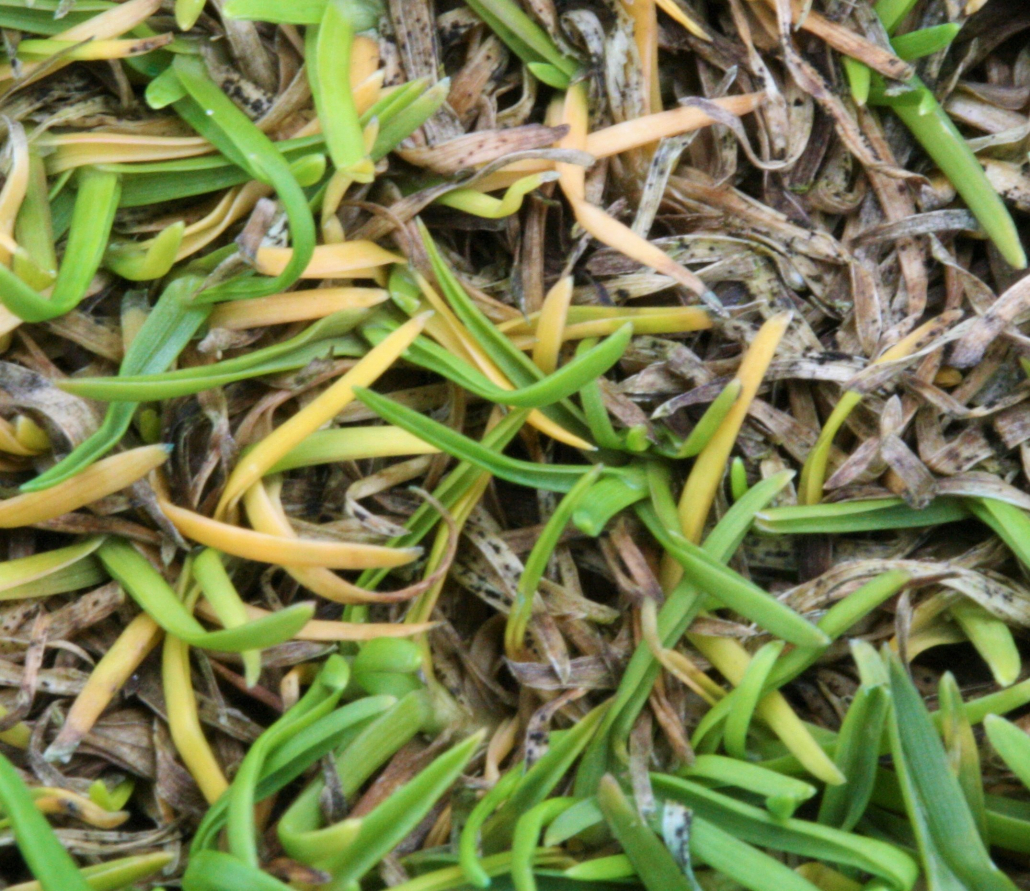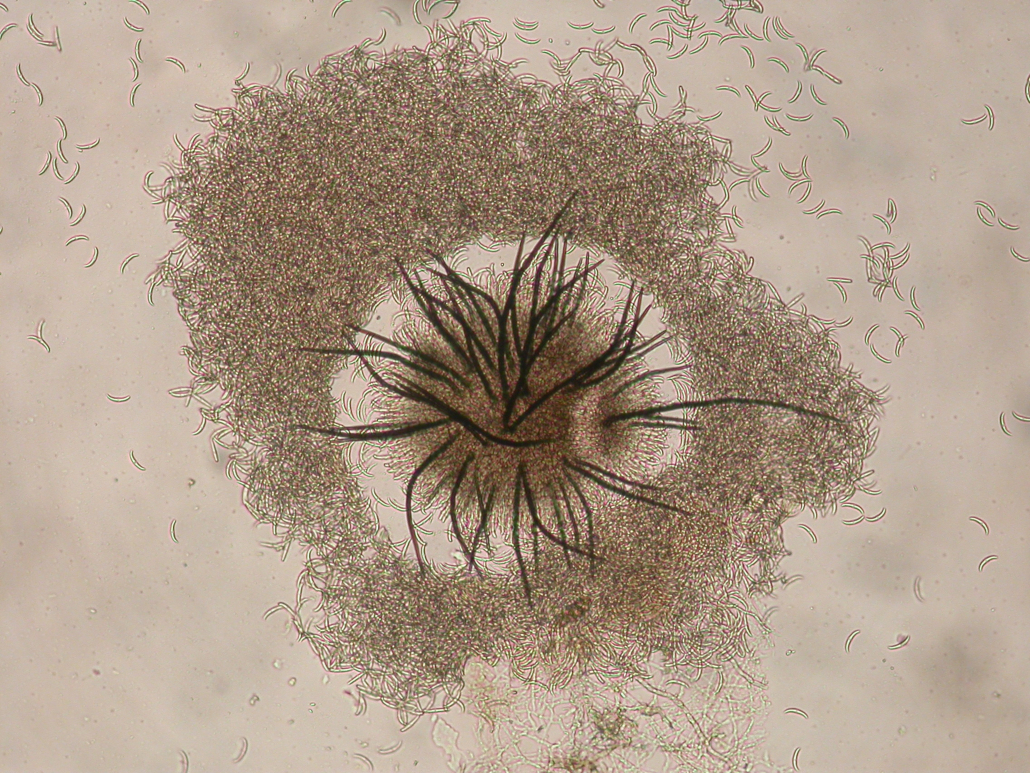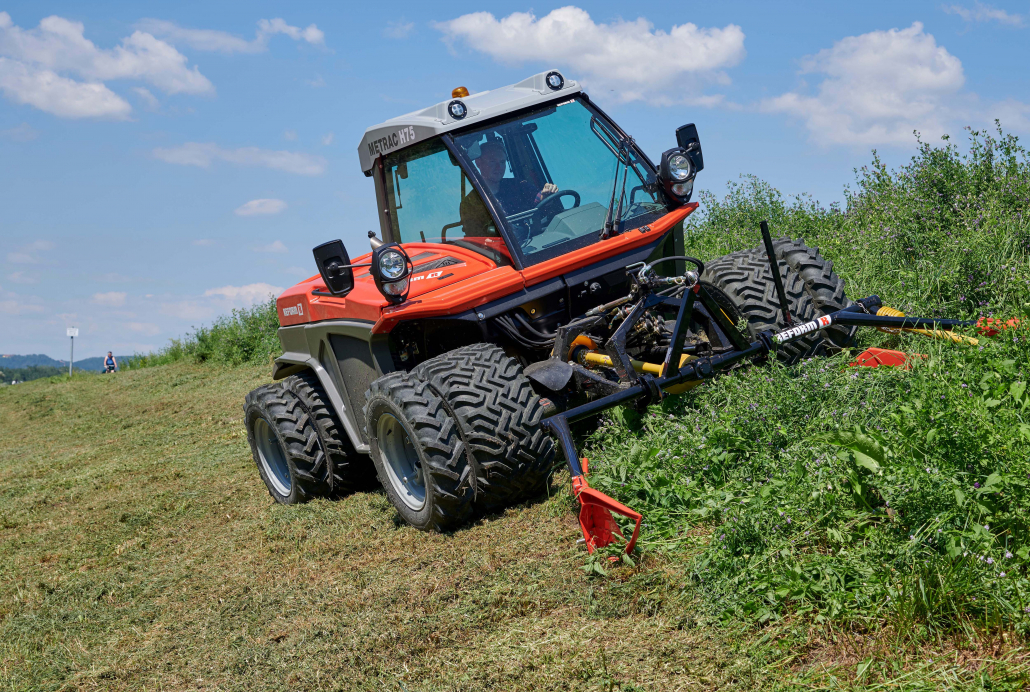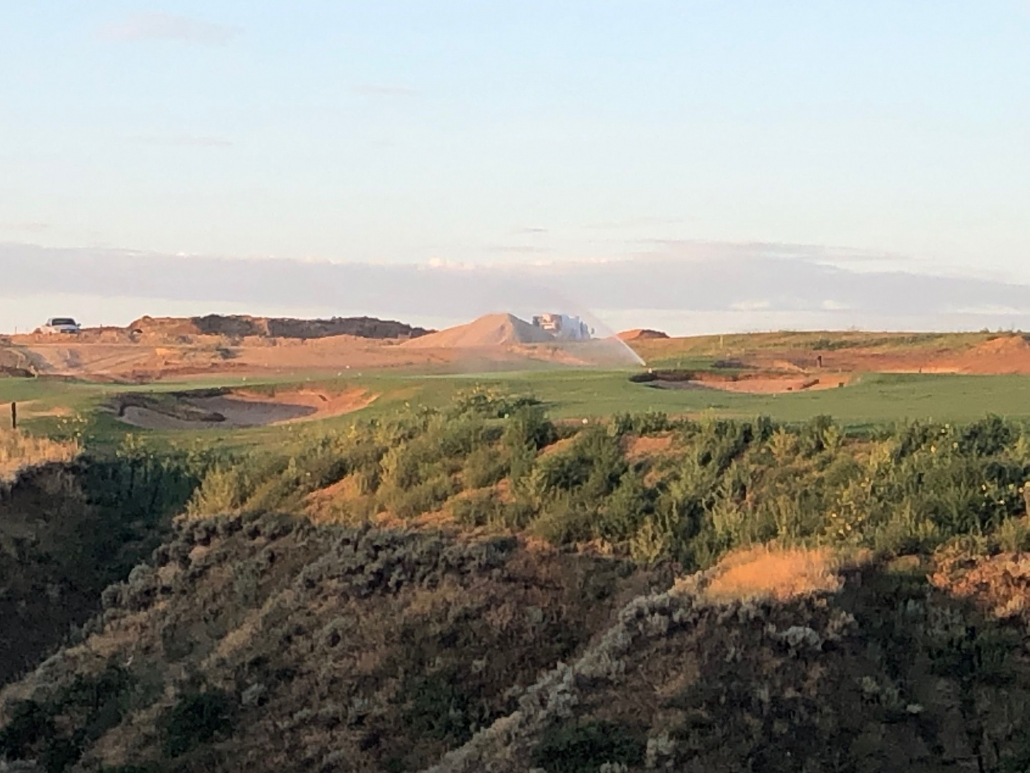Anthracnose: Interactions with the disease triangle: Anthracnose of turf is caused by the pathogen Colletotrichum cereale. The disease primarily affects intensely managed turf surfaces because of the considerable stresses that these environments place on the host plants.
This article describes phases within the lifecycle of anthracnose of turf (figure 1) in the context of the three aspects of the disease triangle; pathogen, host and environment.
Biotrophic phase

Simplified lifecycle of Colletotrichum cereale, the anthracnose pathogen that affects turfgrass.
The pathogen establishes within the host without causing symptoms of disease.
During the biotrophic phase of the anthracnose lifecycle, the pathogen establishes itself within the host plant without alerting the plant to the requirement to respond defensively. It does this by extending primary hyphae, root-like filaments, between the plant cells without actually entering the cells. The pathogen further disguises its presence from the plant using a process called deacetylation, in which chitin on the hyphae is converted to chitosan (Muench, et al., 2008).
The plant does not respond defensively to the pathogen because the hyphae do not enter the plant cells and the presence of chitin, which primes plants to activate defensive mechanisms, is hidden. However, even at this early stage of infection, the pathogen may affect its host negatively by creating a nutrient sink at the site of infection; thus, increasing the nutrients availability for the pathogen whilst reducing the nutrients that are fulfilling plant functions.
Extended periods of leaf wetness allow the pathogen to penetrate the host plant and for the biotrophic phase of development to commence. Practices that reduce leaf wetness; such as use of surfactants and physical removal of dews will help to reduce pathogen establishment at this stage.

Foliar blight on a Poa annua sward showing the characteristic yellowing of leaves and diagnostic black setae.
Necrotrophic phase
The pathogen penetrates into plant tissues and disease symptoms are observed
Necrotrophic growth is characterised by the development of secondary hyphae which penetrate into plant cells. This growth is accompanied by the production of phytotoxins which degrade plant tissue, providing the fungi with a further nutrient source. This phase of growth for anthracnose pathogens which affect other plants typically occurs within 72 hours after the initiation of the biotrophic phase (Mims & Vaillancourt, 2002). The exact timing is not yet known for Colletotrichum cereale, the pathogen that infects turfgrass.
There are two distinctive forms of anthracnose infection during the necrotrophic phase; basal rot and foliar blight (figure 2). It is likely that this symptomatic variance is caused by infection occurring in different parts of the plant.
Foliar blight is characterised by yellow (Poa annua) or reddish (Agrostis stolonifera) lesions on leaves and a water-soaked appearance.
Basal rot is characterised by symptoms in the lower stem or root. The infected tissue at the base of the plant appears dark brown to black with the leaf sheaths above appearing orange to yellow but without foliar lesions.
Development of the disease into the necrotrophic phase is favoured by conditions that put the grass plant under abiotic stress; including low fertility, close mowing, compaction, heat, drought, low light levels and poor drainage. Historic records and weather forecasts are essential to determining when to undertake actions which will minimise the impacts of potential stressors on the plant.
Relevant stresses may be current or historical. For example, the considerable metabolic requirement in spring of Poa annua to produce seedheads takes photosynthate away from roots and shoots prior to a stressful time in the growing season and could weaken the host increasing its susceptibility to infection.

Colletotrichum spp grown in laboratory conditions on potato dextrose agar showing acervuli with diagnostic black setae producing conidia.
Reproductive phase
The pathogen spreads infective material to other areas
The reproductive phase begins with the development of fruiting bodies called acervuli within which the conidia, or spores, are produced (figure 3). Conidia can be transported on the wind or mechanically. Following contact with another susceptible plant, they can adhere to it by producing a suction cup called an appressorium. The pathogen then forces a highly specialised hyphae called a penetration peg into the plant resulting in the initiation of the biotrophic phase.
During the reproductive phase black hair like structures known as setae which project from the acervuli on infected plant tissues are visible with a x10 hand lens. These structures are key diagnostic features for this pathogen when it develops as foliar blight (figure 2 & 3).
Warm, humid weather and increased light intensity are the primary environmental factors controlling the development of conidia. Laboratory studies indicate that Colletotrichum cereale produces conidia at temperatures between 24-32°C with increased maturity of conidia observed at 28°C compared with lower temperatures (Wang & Kerns, 2017). Once conidia have been excreted from the acervuli in a water-soluble matrix they can be spread by wind, water, or human activity but need continued leaf surface moisture to establish.
Research shows that wounding of the host plant through maintenance practices such as verticutting, top dressing and rolling does not increase the incidence of disease as the pathogen does not rely upon entry through wounds or weakened tissues due to its ability to develop a penetration peg.
This article has been written in conjunction with Dr Abigail Graceson and Tom Wood.
Dr Abigail Graceson
As a Technical Manager within the Agrovista Amenity Technical Department, Dr Abigail Graceson draws upon both her practical skills and academic research experience. In addition to her eight years’ experience as a professional gardener & horticulturalist; Dr Graceson spent nine years as a researcher specialising in horticulture, growing media and green roofs.
Tom Wood
Amenity specialist for the Yorkshire region, Tom Wood holds a first class bachelor’s degree in Sportsturf Science and Management (UCLan) which he combines with over ten years’ practical turf management experience. Over this time Tom has amassed a broad range of knowledge and skills sourced from a variety of fields including education, golf courses and technical sales.
References
Mims, C. W. & Vaillancourt, L. J., 2002. Ultrastructural characterization of infection and colonization of maize leaves by Colletotrichum graminicola, and by a C. graminicola pathogenicity mutant. Genetics and resistance, 92(7), pp. 803-812.
Muench, S. et al., 2008. The hemibiotrophic lifestyle of Colletotrichum species. Journal of plant physiology, Volume 165, pp. 41-51.
Wang, Y. & Kerns, J. P., 2017. Temperature effects on formation of appressoria and sporulation of colletotrichum cereale on two turfgrass species. International Turfgrass Society Research Journal, Volume 3, pp. 123-132.
More information on this subject can be found on the Agrovista Amenity Academy. The Agrovista Amenity Academy is an online learning resource with courses and lessons created on a range of areas of turf management and for all products sold by Agrovista Amenity.
For more information about Agrovista UK, visit www.agrovista.co.uk/amenity
For the latest industry news visit turfmatters.co.uk/news
Get all of the big headlines, pictures, opinions and videos on stories that matter to you.
Follow us on Twitter and Instagram for fun, fresh and engaging content.
You can also find us on Facebook for more of your must-see news, features, videos and pictures from Turf Matters.


















